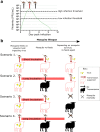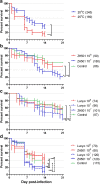Competence of mosquitoes native to the United Kingdom to support replication and transmission of Rift Valley fever virus
- PMID: 29776384
- PMCID: PMC5960175
- DOI: 10.1186/s13071-018-2884-7
Competence of mosquitoes native to the United Kingdom to support replication and transmission of Rift Valley fever virus
Abstract
Background: Rift Valley fever phlebovirus (RVFV) is a mosquito-borne arbovirus causing severe disease in humans and livestock. It is endemic in Africa and spread to the Arabian Peninsula in 2000 raising concerns it could emerge in Europe. The ability of temperate mosquitoes from the United Kingdom (UK) to support replication and transmission of RVFV is unknown.
Methods: In this study, two colonised lines of Culex pipiens, wild-caught Aedes detritus and Ae. rusticus from the UK were infected with pathogenic strains of RVFV to assess their vector competence. Mosquitoes were offered artificial blood-meals containing 106 or 107 plaque forming units (PFU)/ml RVFV, simulating natural peak viraemia in young ruminants, and maintained at 20 °C or 25 °C for up to 21 days. Bodies, legs and saliva were collected and tested for the presence of viral RNA and infectious virus to determine the infection, dissemination and transmission potential.
Results: Across temperatures, doses and strains the average infection, dissemination and transmission rates were: 35, 13 and 5% (n = 91) for Cx. pipiens (Caldbeck); 23, 14 and 5% (n = 138) for Cx. pipiens (Brookwood); 36, 28 and 7% (n = 118) for Ae. detritus. However, despite 35% (n = 20) being susceptible to infection, Ae. rusticus did not transmit RVFV. Survival of Aedes species was negatively affected by maintenance at 25 °C compared to the more representative peak average British summer temperature of 20 °C. Increased mortality was also observed with some species infected with 107 PFU/ml compared to 106 PFU/ml.
Conclusions: It can be concluded that temperate mosquito species present in the UK demonstrate a transmission potential for RVFV in the laboratory but, even at high temperatures, this occurred at low efficiency.
Keywords: Arbovirus; Mosquito; Rift Valley fever virus; UK; Vector competence.
Conflict of interest statement
Ethics approval and consent to participate
Not applicable.
Competing interests
The authors declare that they have no competing interests.
Publisher’s Note
Springer Nature remains neutral with regard to jurisdictional claims in published maps and institutional affiliations.
Figures



Similar articles
-
Culex flavivirus infection in a Culex pipiens mosquito colony and its effects on vector competence for Rift Valley fever phlebovirus.Parasit Vectors. 2018 May 23;11(1):310. doi: 10.1186/s13071-018-2887-4. Parasit Vectors. 2018. PMID: 29792223 Free PMC article.
-
Susceptibility and barriers to infection of Colorado mosquitoes with Rift Valley fever virus.PLoS Negl Trop Dis. 2021 Oct 25;15(10):e0009837. doi: 10.1371/journal.pntd.0009837. eCollection 2021 Oct. PLoS Negl Trop Dis. 2021. PMID: 34695125 Free PMC article.
-
Transmission of Rift Valley fever virus from European-breed lambs to Culex pipiens mosquitoes.PLoS Negl Trop Dis. 2017 Dec 27;11(12):e0006145. doi: 10.1371/journal.pntd.0006145. eCollection 2017 Dec. PLoS Negl Trop Dis. 2017. PMID: 29281642 Free PMC article.
-
The Temperature-Associated Effects of Rift Valley Fever Virus Infections in Mosquitoes and Climate-Driven Epidemics: A Review.Viruses. 2025 Feb 1;17(2):217. doi: 10.3390/v17020217. Viruses. 2025. PMID: 40006972 Free PMC article. Review.
-
Molecular aspects of Rift Valley fever virus and the emergence of reassortants.Virus Genes. 2019 Feb;55(1):1-11. doi: 10.1007/s11262-018-1611-y. Epub 2018 Nov 13. Virus Genes. 2019. PMID: 30426314 Review.
Cited by
-
Emerging Mosquito-Borne Threats and the Response from European and Eastern Mediterranean Countries.Int J Environ Res Public Health. 2018 Dec 7;15(12):2775. doi: 10.3390/ijerph15122775. Int J Environ Res Public Health. 2018. PMID: 30544521 Free PMC article. Review.
-
Oral susceptibility of aedine and culicine mosquitoes (Diptera: Culicidae) to Batai Orthobunyavirus.Parasit Vectors. 2021 Nov 3;14(1):566. doi: 10.1186/s13071-021-05070-0. Parasit Vectors. 2021. PMID: 34732254 Free PMC article.
-
Assessment of the control measures of the category A diseases of Animal Health Law: Rift Valley Fever.EFSA J. 2022 Jan 19;20(1):e07070. doi: 10.2903/j.efsa.2022.7070. eCollection 2022 Jan. EFSA J. 2022. PMID: 35079289 Free PMC article.
-
A Review of Nonhuman Primate Models of Rift Valley Fever Virus Infection: Progress, Challenge Strains, and Future Directions.Pathogens. 2024 Oct 1;13(10):856. doi: 10.3390/pathogens13100856. Pathogens. 2024. PMID: 39452727 Free PMC article. Review.
-
Mechanistic models of Rift Valley fever virus transmission: A systematic review.PLoS Negl Trop Dis. 2022 Nov 18;16(11):e0010339. doi: 10.1371/journal.pntd.0010339. eCollection 2022 Nov. PLoS Negl Trop Dis. 2022. PMID: 36399500 Free PMC article.
References
-
- Daubney R, Hudson JR, Garnham PC. Enzootic hepatitis or Rift Valley fever. An undescribed virus disease of sheep cattle and man from East Africa. J Pathol. 1931;34:545–579. doi: 10.1002/path.1700340418. - DOI
Publication types
MeSH terms
Grants and funding
LinkOut - more resources
Full Text Sources
Other Literature Sources

